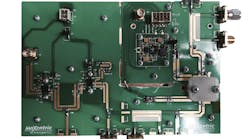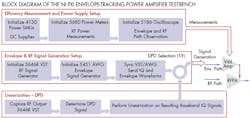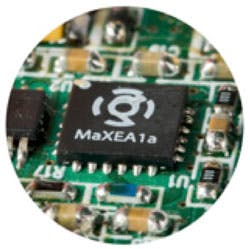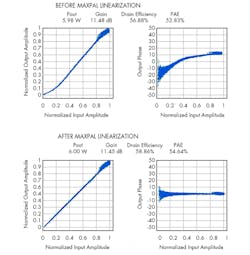This file type includes high resolution graphics and schematics when applicable.
The need for greater spectral efficiency among next-generation communication standards, such as 4G/5G, has led to the use of more complex modulation schemes to address an increasing demand for higher data rates. Older modulation schemes based on phase or frequency modulation with no amplitude information carried on the signal could be supported by power amplifiers (PAs) driven into compression, and thus operating at higher levels of power-added efficiency (PAE).
However, due to the need for spectral efficiency, modulation schemes that include amplitude variations lead to signals with non-constant envelope and high peak-to-average signal ratio, resulting in PAs that frequently operate below their compression point and at lower PAE values.
The efficiency of the PA determines the power consumption, size, and battery lifetime of the radio. Various techniques, such as envelope tracking (ET), have been explored to increase the efficiency of PAs for high peak-to-average power ratio (PAPR). ET adjusts the supply voltage applied to an RF PA to deliver the power needed at that instant.
This article describes the development of an envelope tracking power amplifier (ETPA) test bench capability for real-time efficiency and linearity measurements for optimizing ETPA design, along with flexibility to accommodate different 5G signals. This capability uses NI LabVIEW software to test and optimize the ETPA, in addition to a vector signal transceiver (VST) for RF signal generation and an arbitrary waveform generator (AWG) for envelope signal generation. The design, on-board retuning, and final optimization are performed with the NI AWR Design Environment.
ET technology enables operators to utilize only as much power as is necessary to provide the amplified output. This technology reduces energy consumption, thus significantly lowering operating costs while providing environmental sustainability. In addition, from the hardware system perspective, this allows a smaller form factor and higher reliability due to lower junction temperatures, as well as much lower weight due to reduced battery and energy requirements.
Aside from designing for high efficiency, today’s PA designers must be concerned about amplifier linearity maintaining signal integrity in a crowded frequency spectrum allocation. High linearity is required in these communication systems in order to minimize signal distortion, reduce bit error rate (BER), and reduce adjacent channel interference.
Advantages of NI PXI Hardware and LabVIEW Software
Traditional test benches are made to test PAs with a constant supply voltage. With ET, a modulator is used as a dynamic power supply that varies as a function of the signal’s envelope. This technique is deliberately designed for signals with high PAPR; hence, traditional PA tests cannot be used to validate their performance. Communication systems need to be developed based on the average performance of an ETPA operating under typical modulation conditions, as opposed to continuous-wave (CW) performance at the peak supply voltage. The problem is further complicated by the lack of accurate simulation models over a wide range of supply voltages. Most device models are valid at the nominal constant supply voltage ±10%. With ET, the supply voltage can be 90% lower than the peak supply voltage. Thus, real-time performance measurements are highly desired for optimizing the ETPA.
Test benches built in the past have taken a year or more to complete. With NI’s integration and the use of LabVIEW, the designers were able to complete the NI ET test-bench in less than two months. An important feature that PXI offers is the ease of synchronization between equipment modules.
Due to the nature of ET, it is critical that the supply envelope signal arrive at a specific time with respect to the RF signal. Additionally, 5G PAs need to support various types of modulations, which the VST can generate. Another advantage of the VST is its wide frequency range of 65 MHz to 6 GHz. And with 200 MHz of instantaneous bandwidth, the VST allows system flexibility for various applications.
Because envelope tracking is inherently wideband in terms of tunable RF bandwidth, a wideband ETPA with this NI ET test bench can be used to test various LTE bands, GPS, and military applications—all in the same day, with simply a click to change the RF frequency.
Optimizing with the VST and Microwave Office Software
To develop a test bench for optimizing envelope tracking, the various modules described in Fig. 1 were used. Power source measurement units (SMUs) were employed to allow for real-time DC power consumption measurements. The RF power meters enabled engineers to monitor the input and output power. In LabVIEW, these measurements are put together and calculations are performed to allow for instantaneous monitoring of the efficiency, gain, and output power.
The envelope signal was generated using the AWG. The VST served as the RF signal generator as well as the RF feedback analyzer. The envelope shaping relationship between the true envelope of the signal and the supply voltage was optimized easily by simply loading a different equation. In addition to addressing the PA efficiency through real-time ET, digital pre-distortion (DPD), using the feedback signal and MathScript, was used to improve the linearity of the ETPA.
To further improve the performance, impedance tuning was applied based on information derived from load and source pulling with external tuners. The Microwave Office software was used to apply the optimized tuning to the on-board ETPA RF matching circuitry. The reduced characterization time and capability to optimize the ETPA in real-time is a significant game-changer for PA designers.
The time alignment of the amplitude signal and RF signal at the RF transistor is critical for optimizing the ETPA’s performance. A time misalignment in these two signals will produce signal distortion, degrade adjacent channel power ratio (ACPR) performance, and reduce efficiency. Characterization of the time-delay difference between these two signal paths will allow for time alignment.
This delay difference may vary with temperature or aging. Therefore, the system needs to compensate for this variation to ensure optimum performance. Using NI’s PXI, VST, AWG, and LabVIEW, the designers were able to visually see the improvement/degradation in linearity and efficiency as the alignment between the RF signal and the envelope supply was altered in real-time.
Results of Envelope Tracking
The NI VST and PXI were used to optimize the LTE Band 1 (2.14 GHz) PA using MaXentric’s MaXEA 1.0 modulator (Fig. 2). The MaXEA 1.0, designed for micro base stations, is a 30-V integrated envelope modulator with greater than 70% modulator efficiency. It can deliver up to 7 W of average envelope output power. It is designed to support signals with high PAPRs, such as those used in 4G/5G. The MaXEA 1.0 is compatible with various PA technologies—among them, laterally diffused metal oxide semiconductor (LDMOS), gallium-nitride (GaN), and gallium-arsenide (GaAs).
In this example, a GaN device was used for the PA design. The PA was tuned and optimized for ET operation using the NI PXI system. Initial output and input external tuners were used to optimize the efficiency, gain, and output power of the ETPA. The desired input and output impedances were measured with a vector network analyzer (VNA). Microstrip-based board matching circuits were designed and simulated with Microwave Office (Fig. 3). The retuned ETPA was then measured again using the PXI, VST, and LabVIEW ET setup to confirm its performance. Time alignment between the RF (VST) and the envelope (AWG) paths was performed digitally in LabVIEW for best efficiency and linearity. â¨
Without linearization, the ETPA achieved 6 W of output power with 11.5 dB of gain and 53% PAE. After applying MaXentric’s linearization (implemented in LabVIEW with MathScript), the output power and gain remained the same. The PAE slightly improved to 54.6%, with better than -45 dBc ACPR. To demonstrate how ET can improve efficiency and linearity, measurements were performed for the same GaN device under constant drain biasing. Achieving the same linearity performance without ET required the input power to be significantly reduced. The results were a low efficiency of 6.1% at 0.5-W output power without DPD and 22.5% efficiency at 2 W of output power with DPD. Fig. 4 shows the MaXentric ETPA with MaXEA (a), the spectra before and after MaXPAL linearization (b), the AM/AM and AM/PM before MaXPAL linearization (c), and the AM/AM and AM/PM after MaXPAL linearization (d).
Conclusion
The synergy between the NI measurement equipment and NI AWR Design Environment enabled the design success of the ETPA. This solution helped the designers significantly reduce PA optimization time without sacrificing measurement accuracy. The flexibility and widely tunable RF frequency offered by the VST allowed the designers to design, optimize, and demonstrate wideband ETPAs across different bands and applications all in the same day. Load-pull tuning and impedance matching circuitry designed in Microwave Office further improved PA performance.
This file type includes high resolution graphics and schematics when applicable.







